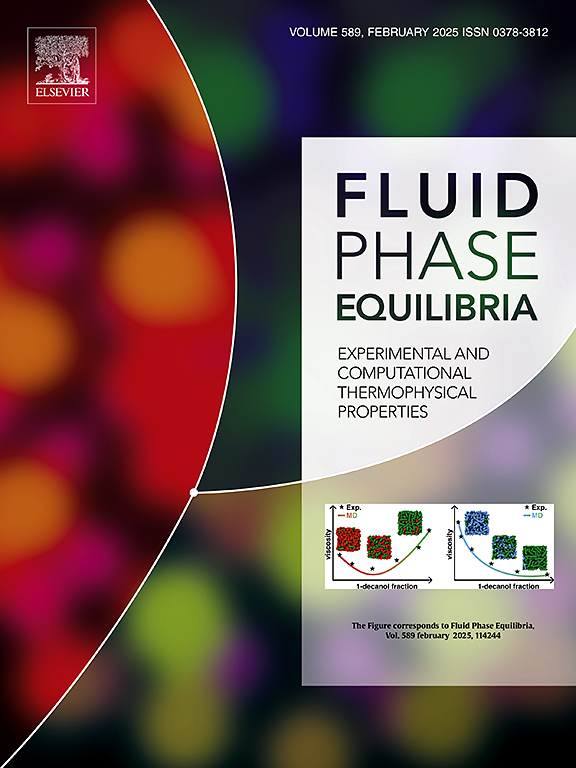Study on the dissociation conditions of methane hydrate in silty-clayey sediments
IF 2.8
3区 工程技术
Q3 CHEMISTRY, PHYSICAL
引用次数: 0
Abstract
Natural gas hydrate is widely distributed in silty-clayey sediments, that occur largely in a highly dispersed state. However, the phase equilibria of methane hydrate in the presence of clay and how surface adsorption associated with clay particles affect natural gas hydrate thermodynamics and stability are not fully elucidated and warrant investigation. In this study, the dissociation conditions of methane hydrate in representative silty-clayey sediments (sand, montmorillonite and illite) with a water content of ∼20 % at different clay contents (10, 30, 50, 70 and 100 wt%) were measured using the multi-step heating method. The results indicated that montmorillonite has a greater dissociation temperature depression compared to illite. In the pure montmorillonite system, the temperature depression of methane hydrate is up to -2.24 K at a pressure of 11.69 MPa compared to pure water, however, that for illite is very small, less than -0.5 K. When the montmorillonite content decreases from 100 wt% to 70 wt%, the dissociation temperature of methane hydrate decreases significantly. As the montmorillonite content decreases below 50 wt%, the dissociation temperature of methane hydrate in silty-clayey sediments is almost the same as bulk hydrates, which due to the clay sediments is almost saturated with water. Furthermore, we introduce the Van Genuchten (VG) model to quantify the effect of clay content on water potential (matric suction) in unsaturated clays. Based on the classical van der Waals model, the VG model has successfully been applied to calculate methane hydrate phase equilibria in clay-bearing sediments, with a maximum absolute deviation (AADP) <5 %. It reveals that montmorillonite, characterized by its strong capacity for interlayer water absorption, shows an approximately exponential increase in matric suction as clay content rises. In contrast, the matrix suction of illite is weak, which can be approximately considered as a linear increase with the increase of clay content.
求助全文
约1分钟内获得全文
求助全文
来源期刊

Fluid Phase Equilibria
工程技术-工程:化工
CiteScore
5.30
自引率
15.40%
发文量
223
审稿时长
53 days
期刊介绍:
Fluid Phase Equilibria publishes high-quality papers dealing with experimental, theoretical, and applied research related to equilibrium and transport properties of fluids, solids, and interfaces. Subjects of interest include physical/phase and chemical equilibria; equilibrium and nonequilibrium thermophysical properties; fundamental thermodynamic relations; and stability. The systems central to the journal include pure substances and mixtures of organic and inorganic materials, including polymers, biochemicals, and surfactants with sufficient characterization of composition and purity for the results to be reproduced. Alloys are of interest only when thermodynamic studies are included, purely material studies will not be considered. In all cases, authors are expected to provide physical or chemical interpretations of the results.
Experimental research can include measurements under all conditions of temperature, pressure, and composition, including critical and supercritical. Measurements are to be associated with systems and conditions of fundamental or applied interest, and may not be only a collection of routine data, such as physical property or solubility measurements at limited pressures and temperatures close to ambient, or surfactant studies focussed strictly on micellisation or micelle structure. Papers reporting common data must be accompanied by new physical insights and/or contemporary or new theory or techniques.
 求助内容:
求助内容: 应助结果提醒方式:
应助结果提醒方式:


